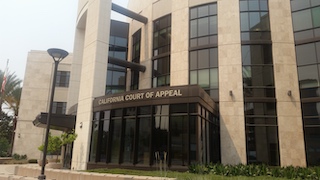On August 15, 2016, Orange County Sheriff’s Deputy Phillip Avalos and several of his fellow deputies went to Javier Juan Murillo’s house to execute a warrant for his arrest.
When deputies announced their presence at the house, Murillo jumped out his bedroom window and ran down the street. Deputy Avalos chased him into a neighbor’s yard and tackled him. A struggle ensued. Avalos punched Murillo many times until a second deputy arrived and Murillo was finally taken into custody. Murillo had two knives and two hypodermic needles in his pockets.
The Orange County District Attorney charged Murillo with violating Penal Code § 69, felony resisting arrest with use of force (Penal Code § 69), delaying a police officer (Penal Code § 148(a)(1)), and possession of drug paraphernalia (Health & Safety Code § 11364).
Before trial, Murillo filed a Pitchess motion to discover any information in Avalos’ personnel file reflecting dishonesty, moral turpitude or excessive use of force. Pitchess v. Superior Court (1974) 11 Cal. 3d 531. Murillo contended he had surrendered to Avalos before any struggle began, so once Murillo tackled him and began using force, this was unnecessary and Murillo was no longer acting within the scope of legal duties, so Murillo could not be convicted of resisting a police officer acting in the performance of his or her duties (Penal Code § 69). The judge inspected Avalos’ file and found no documentation supporting Murillo’s request.
Murillo was then convicted and served a two-year prison sentence, but after this, the prosecution informed defense counsel of an Internal Criminal Investigation (ICI) report that was issued by the Orange County Sheriff’s Department in 2018, about a year after Murillo’s trial ended.
The report focused on Avalos’ evidence booking practices between February 1, 2016, and February 1, 2018, and found that in fifty-one cases, Avalos made false statements in five of those cases.
 CA 4th Appellate District Div 3 OC
CA 4th Appellate District Div 3 OC
In three of those cases, Avalos wrote that he had collected certain items (such as drugs, knives and photographic evidence) into evidence when in fact he had not done so. In the two other cases, he booked evidence considerably later than when he said he did.
Based on the ICI report, Murillo moved through counsel to vacate his resisting conviction under Penal Code § 1473.6(a)(2) on grounds that the report constituted newly discovered evidence that Avalos had testified falsely at trial.
Penal Code § 1473.6(a)(2) permits one to request that a judge vacate a conviction based on “newly discovered evidence of fraud by a government official that completely undermines the prosecution’s case, is conclusive and points unerringly to his or her innocence.”
This statute was enacted in response to the so-called Rampart Scandal in which several LAPD officers were found to have planted evidence, falsified reports and committed perjury. People v. Germany (2005) 133 Cal. App. 4th 784, 791.
Pursuant to subdivision (c) of the statute, the judge is directed to follow the same procedures applicable to a petition for writ of habeas corpus. See Cal. Rules of Court, rule 4.551. Therefore, if the moving party makes a prima facie case for relief, the judge must issue an order to show cause hearing. In determining whether a prima facie case has been made, the judge must take the moving party’s factual allegations as true and make a preliminary assessment whether the moving party would be entitled to relief if his or her factual allegations were proven.
The trial court judge denied the motion, explaining that he had presided over the trial and considered Deputy Avalos to be a credible witness and that the judge did not find any nexus between the evidence revealed in the ICI report and Avalos’ testimony at trial. He opined that it would be a “huge stretch” to conclude Avalos lied at trial just because he “was late in booking evidence on an unrelated case.”
Murillo then appealed the ruling to the Fourth Appellate District, arguing that the judge erred in denying the motion without issuing an order to show cause hearing.
The Fourth Appellate District agreed with Murillo and reversed the trial court’s order denying Murillo’s motion to vacate. It then remanded the matter back to the trial court with instructions to assign the matter to a different judge and to issue an order to show cause to resolve Murillo’s motion in accordance with a petition for writ of habeas corpus.
We offer this summary to show, once again, how Orange County judges and the Orange County Sheriff’s Department can act, but more importantly, what the proper procedure is for a judge ruling on a motion for vacatur under Penal Code § 1473.6(a)(2).
The citation for the Fourth Appellate District Court ruling discussed above is People v. Javier Juan Murillo (4th App. Dist., 2021) 71 Cal. App. 5th 1019, 286 Cal. Rptr. 3d 695.
For more information about a motion to vacate or a petition for a writ of habeas corpus based on newly discovered evidence, please click on the following articles:
 CA 4th Appellate District Div 3 OC
CA 4th Appellate District Div 3 OC